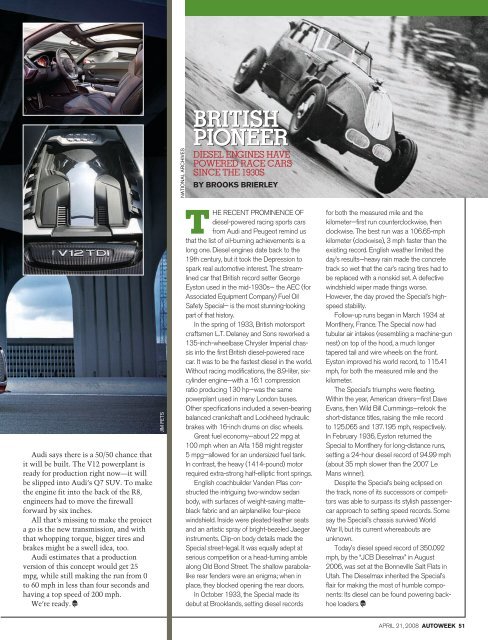SPECIAL EARTH DAY DOUBLE ISSUE - AutoWeek
SPECIAL EARTH DAY DOUBLE ISSUE - AutoWeek
SPECIAL EARTH DAY DOUBLE ISSUE - AutoWeek
Create successful ePaper yourself
Turn your PDF publications into a flip-book with our unique Google optimized e-Paper software.
Audi says there is a 50/50 chance that<br />
it will be built. The V12 powerplant is<br />
ready for production right now—it will<br />
be slipped into Audi’s Q7 SUV. To make<br />
the engine fit into the back of the R8,<br />
engineers had to move the firewall<br />
forward by six inches.<br />
All that’s missing to make the project<br />
a go is the new transmission, and with<br />
that whopping torque, bigger tires and<br />
brakes might be a swell idea, too.<br />
Audi estimates that a production<br />
version of this concept would get 25<br />
mpg, while still making the run from 0<br />
to 60 mph in less than four seconds and<br />
having a top speed of 200 mph.<br />
We’re ready. c<br />
JIM FETS<br />
NATIONAL ARCHIVES<br />
BRITISH<br />
PIONEER<br />
DIESEL ENGINES HAVE<br />
POWERED RACE CARS<br />
SINCE THE 1930S<br />
BY BROOKS BRIERLEY<br />
THE RECENT PROMINENCE OF<br />
diesel-powered racing sports cars<br />
from Audi and Peugeot remind us<br />
that the list of oil-burning achievements is a<br />
long one. Diesel engines date back to the<br />
19th century, but it took the Depression to<br />
spark real automotive interest. The streamlined<br />
car that British record setter George<br />
Eyston used in the mid-1930s— the AEC (for<br />
Associated Equipment Company) Fuel Oil<br />
Safety Special— is the most stunning-looking<br />
part of that history.<br />
In the spring of 1933, British motorsport<br />
craftsmen L.T. Delaney and Sons reworked a<br />
135-inch-wheelbase Chrysler Imperial chassis<br />
into the first British diesel-powered race<br />
car. It was to be the fastest diesel in the world.<br />
Without racing modifications, the 8.9-liter, sixcylinder<br />
engine—with a 16:1 compression<br />
ratio producing 130 hp—was the same<br />
powerplant used in many London buses.<br />
Other specifications included a seven-bearing<br />
balanced crankshaft and Lockheed hydraulic<br />
brakes with 16-inch drums on disc wheels.<br />
Great fuel economy—about 22 mpg at<br />
100 mph when an Alfa 158 might register<br />
5 mpg—allowed for an undersized fuel tank.<br />
In contrast, the heavy (1414-pound) motor<br />
required extra-strong half-elliptic front springs.<br />
English coachbuilder Vanden Plas constructed<br />
the intriguing two-window sedan<br />
body, with surfaces of weight-saving matteblack<br />
fabric and an airplanelike four-piece<br />
windshield. Inside were pleated-leather seats<br />
and an artistic spray of bright-bezeled Jaeger<br />
instruments. Clip-on body details made the<br />
Special street-legal. It was equally adept at<br />
serious competition or a head-turning amble<br />
along Old Bond Street. The shallow parabolalike<br />
rear fenders were an enigma; when in<br />
place, they blocked opening the rear doors.<br />
In October 1933, the Special made its<br />
debut at Brooklands, setting diesel records<br />
for both the measured mile and the<br />
kilometer—first run counterclockwise, then<br />
clockwise. The best run was a 106.65-mph<br />
kilometer (clockwise), 3 mph faster than the<br />
existing record. English weather limited the<br />
day’s results—heavy rain made the concrete<br />
track so wet that the car’s racing tires had to<br />
be replaced with a nonskid set. A defective<br />
windshield wiper made things worse.<br />
However, the day proved the Special’s highspeed<br />
stability.<br />
Follow-up runs began in March 1934 at<br />
Montlhery, France. The Special now had<br />
tubular air intakes (resembling a machine-gun<br />
nest) on top of the hood, a much longer<br />
tapered tail and wire wheels on the front.<br />
Eyston improved his world record, to 115.41<br />
mph, for both the measured mile and the<br />
kilometer.<br />
The Special’s triumphs were fleeting.<br />
Within the year, American drivers—first Dave<br />
Evans, then Wild Bill Cummings—retook the<br />
short-distance titles, raising the mile record<br />
to 125.065 and 137.195 mph, respectively.<br />
In February 1936, Eyston returned the<br />
Special to Montlhery for long-distance runs,<br />
setting a 24-hour diesel record of 94.99 mph<br />
(about 35 mph slower than the 2007 Le<br />
Mans winner).<br />
Despite the Special’s being eclipsed on<br />
the track, none of its successors or competitors<br />
was able to surpass its stylish passengercar<br />
approach to setting speed records. Some<br />
say the Special’s chassis survived World<br />
War II, but its current whereabouts are<br />
unknown.<br />
Today’s diesel speed record of 350.092<br />
mph, by the “JCB Dieselmax” in August<br />
2006, was set at the Bonneville Salt Flats in<br />
Utah. The Dieselmax inherited the Special’s<br />
flair for making the most of humble components:<br />
Its diesel can be found powering backhoe<br />
loaders. c<br />
APRIL 21, 2008 AUTOWEEK 51



